Chapter 4
Profile of Petitioned Status Offense Cases
Status offenses are acts that are illegal only because the persons committing them are of juvenile status. The four major status offense categories used in this Report are running away, truancy, ungovernability (also known as incorrigibility or being beyond the control of one's parents), and underage liquor law violations (e.g., a minor in possession of alcohol, underage drinking). A number of other behaviors may be considered status offenses (e.g., curfew violations, tobacco offenses). Because of the heterogeneity of these miscellaneous offenses, they are not discussed independently in this Report but are included in discussions and displays of petitioned status offense totals.
Agencies other than juvenile courts are responsible for processing status offense cases in many jurisdictions. In some communities, for example, family crisis units, county attorneys, and social service agencies have assumed this responsibility. When a juvenile charged with a status offense is referred to juvenile court, the court may divert the juvenile away from the formal justice system to other agencies for service or may decide to process the juvenile formally with the filing of a petition. The analyses in this Report are limited to petitioned cases.
The manner in which status offense cases come to the attention of the juvenile court varies by offense. For example, law enforcement agencies referred 43% of runaway cases that were formally handled in juvenile court between 1985 and 2002 and just 11% of truancy and 16% of ungovernability cases. Law enforcement agencies were more likely to be the referral source for liquor law violations than for other status offense cases, referring 91% of such cases that were formally handled in juvenile court between 1985 and 2002.
Juvenile courts may adjudicate petitioned status offense cases and may order sanctions such as probation or out-of-home placement. While their cases are being processed, juveniles charged with status offenses are sometimes held in secure detention. (Note that the Juvenile Justice and Delinquency Prevention Act discourages secure detention of status offenders. States holding large numbers of status offenders in secure detention risk losing a significant portion of their juvenile justice block grant awards.)
Because of variations in data collection and storage, the available data cannot support national estimates of the volume of petitioned status offense cases and trends in these cases. Therefore, this chapter presents a sample-based profile of cases disposed between 1985 and 2002, including demographic characteristics of the juveniles involved, types of offenses charged, and the flow of cases as they move through juvenile court processing.
Age
-
Overall, the volume of petitioned status offense cases peaked at age 15.
-
Youth age 15 or younger accounted for 59% of formally processed status offense cases disposed by the courts. This included 66% of all runaway cases, 72% of ungovernability cases, 78% of truancy cases, and 26% of liquor law violation cases.
-
Age-specific patterns differed among the individual status offense categories. Among cases involving runaway, truancy, and ungovernability offenses, the proportions of the caseloads peaked at age 15 and decreased substantially by age 17.
-
For cases involving liquor law violations, the proportion of the caseload increased continuously with age. Youth age 14 accounted for 7% of the petitioned status offense caseload involving liquor law violations, while 15-year-olds accounted for 16%, 16- year-olds accounted for 32%, and 17- year-olds comprised 42% of the liquor law violation caseload.
Unlike the other status offense categories, the volume of petitioned liquor law violation cases continued to increase with age
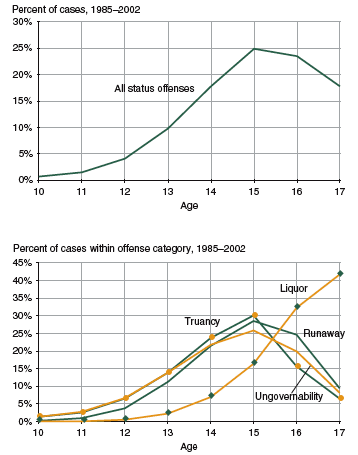
|
Data Table
|
|
Age
|
Total
|
Runaway
|
Truancy
|
Ungovernability
|
Liquor
|
|
|
10
|
0%
|
0%
|
1%
|
1%
|
0%
|
|
11
|
1 |
1
|
3 |
3
|
0
|
|
12
|
4 |
4
|
6
|
7 |
0
|
|
13
|
10 |
11 |
14 |
14
|
2 |
|
14
|
18 |
21 |
24
|
22
|
7
|
|
15
|
25 |
29 |
30 |
26
|
16
|
|
16
|
24
|
25 |
16 |
20
|
32
|
|
17
|
18 |
9 |
7 |
8 |
42
|
| |
|
Total
|
100%
|
100%
|
100%
|
100%
|
100%
|
Note:
Detail may not total 100% because of rounding.
|
Gender and Race
The proportion of females was greatest in petitioned runaway cases

White juveniles accounted for the greatest proportion (90%) of petitioned status offense cases involving liquor law violations
Males were involved in 58% of the total petitioned status offense caseload.
Males accounted for the large majority (70%) of status liquor law violation cases.
Females accounted for 61% of petitioned runaway cases, the only status offense category In which females represented a larger proportion of the caseload than males.
Males represented a slight majority of both petitioned truancy and ungovernability cases (54% each).
White youth represented 80% of the population under juvenile court jurisdiction between 1985 and 2002. During this period, they were involved in 77% of all formally processed status offense cases, a proportion comparable to their representation in the general juvenile population.
While white youth were involved in 73% of both runaway and truancy cases and 71% of ungovernability cases, they represented 90% of the petitioned liquor law violation caseload.
Detention
Youth age 15 or younger accounted for 58% of the petitioned status offense cases that involved detention.
Cases involving youth age 16 or older accounted for the large majority (72%) of liquor offense cases involving detention.
Cases involving youth age 15 or younger accounted for 83% of truancy cases, 71% of ungovernability cases, and 67% of runaway cases that involved detention.
Percentage of petitioned status offense cases detained:
Most serious offense |
1985–2002 |
|
All status offenses |
9% |
Runaway |
16 |
Truancy |
4 |
Ungovernability |
10 |
Liquor |
8 |
Percentage of petitioned status offense cases detained by age, 1985–2002:
Most serious offense |
Age 15 or
younger |
Age 16 or older |
|
All status offenses |
9% |
9% |
Runaway |
17 |
16 |
Truancy |
4 |
3 |
Ungovernability |
10 |
10 |
Liquor |
8 |
7 |
Youth age 15 or younger accounted for more than two-thirds of runaway cases involving detention
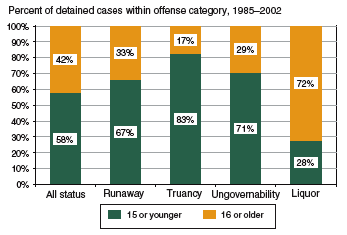
Females accounted for 58% of runaway cases involving detention
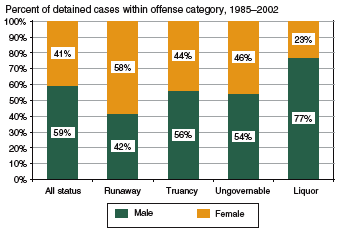
The greater proportion of white youth in detained status offense cases was most evident in liquor law violation cases
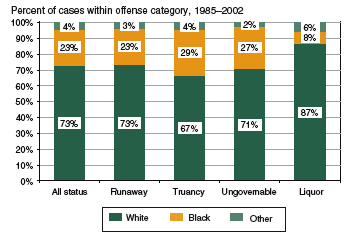
Percentage of petitioned status offense cases detained by gender, 1985–2002:
Most serious offense |
Male |
Female |
|
All status offenses |
9% |
8% |
Runaway |
18 |
16 |
Truancy |
4 |
3 |
Ungovernability |
10 |
10 |
Liquor |
8 |
6 |
Percentage of petitioned status offense cases detained by race, 1985–2002:
Most serious offense |
White |
Black |
Other races |
|
All status offenses |
8% |
10% |
9% |
Runaway |
17 |
16 |
17 |
Truancy |
3 |
4 |
4 |
Ungovernability |
10 |
10 |
11 |
Liquor |
7 |
14 |
7 |
Youth in all racial groups were more likely to be detained for runaway cases than other case types.
Even though the petitioned status offense caseload of white youth and youth of other races contained a greater proportion of liquor law violations than that of black youth, status liquor law violation cases involving black juveniles were more likely to involve detention (14%) than cases involving white youth (7%) or youth of other races (7%).
Adjudication
Age
Overall, the likelihood of adjudication in petitioned status offense cases was greater for younger juveniles.
Within each of the four major status offense categories, petitioned status offense cases involving younger juveniles were more likely to result in the youth being adjudicated a status offender than those involving older juveniles.
For both age groups, petitioned runaway cases were least likely to result in the youth being adjudicated a status offender.
Gender
Formally handled status cases involving males were more likely to be adjudicated than were those involving females (61% vs. 58%).
The likelihood of adjudication for males and females differed only slightly within each of the four major status offense categories.
Race
Overall, adjudication was more likely for petitioned cases involving youth of other races (65%) than for cases involving white youth (61%) and black youth (55%).
For petitioned status offense cases involving liquor law violations, the proportion in which the youth was adjudicated a status offender was higher for youth of other races (71%) and white youth (63%) than for black youth (52%).
Across demographic categories, the majority of petitioned status offense cases were adjudicated
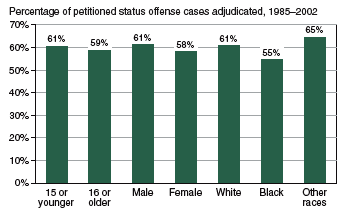
With the exception of runaway cases, most petitioned status offense
cases resulted in the youth being adjudicated as a status offender
|
Most serious offense
|
Demographic |
Total |
Runaway |
Truancy |
Ungovernability |
Liquor |
|
All |
60% |
46% |
63% |
63% |
63% |
Age |
|
|
|
|
|
15 or younger |
61 |
48 |
63 |
64 |
66 |
16 or older |
59 |
42 |
61 |
60 |
62 |
Gender |
|
|
|
|
|
Male |
61 |
47 |
63 |
63 |
64 |
Female |
58 |
45 |
63 |
62 |
61 |
Race |
|
|
|
|
|
White |
61 |
46 |
63 |
64 |
63 |
Black |
55 |
44 |
63 |
57 |
52 |
Other races |
65 |
52 |
66 |
72 |
71 |
Probation was the most common disposition for adjudicated status
offense cases
Percentage of adjudicated status offense cases resulting in out-of-home placement,
1985–2002:
|
Most serious offense
|
Demographic |
Total |
Runaway |
Truancy |
Ungovernability |
Liquor |
|
All |
15% |
27% |
11% |
26% |
8% |
Age |
|
|
|
|
|
15 or younger |
17 |
27 |
12 |
26 |
9 |
16 or older |
12 |
26 |
8 |
24 |
7 |
Gender |
|
|
|
|
|
Male |
15 |
29 |
11 |
26 |
9 |
Female |
15 |
25 |
10 |
25 |
5 |
Race |
|
|
|
|
|
White |
14 |
26 |
11 |
26 |
7 |
Black |
20 |
29 |
11 |
23 |
15 |
Other races |
14 |
21 |
13 |
26 |
10 |
Percentage of adjudicated status offense cases resulting in probation, 1985–2000:
|
Most serious offense
|
Demographic |
Total |
Runaway |
Truancy |
Ungovernability |
Liquor |
|
All |
62% |
61% |
78% |
66% |
57% |
Age |
|
|
|
|
|
15 or younger |
65 |
62 |
78 |
65 |
61 |
16 or older |
57 |
60 |
77 |
67 |
56 |
Gender |
|
|
|
|
|
Male |
60 |
58 |
77 |
66 |
57 |
Female |
59 |
64 |
79 |
66 |
59 |
Race |
|
|
|
|
|
White |
60 |
61 |
76 |
64 |
57 |
Black |
70 |
62 |
82 |
72 |
65 |
Other races |
61 |
71 |
79 |
65 |
55 |
Note: In addition to out-of-home placement and probation, possible dispositions for adjudicated
status offense cases include other sanctions (e.g., fines) and release.
Disposition
Age
Once adjudicated, status offense cases involving younger juveniles were somewhat more likely to result in out-of-home placement than were cases involving older juveniles.
For both age groups, larger proportions of adjudicated runaway and ungovernability cases resulted in outof- home placement than cases that involved truancy and liquor offenses.
Gender
Race
Adjudicated ungovernable cases involving black youth were much more likely to result in formal probation (72%) than cases involving white youth (64%) or youth of other races (65%); adjudicated ungovernable cases involving black youth were less likely to result in out-of-home placement (23%) than cases involving white youth and youth of other races (26% for both).
Adjudicated runaway cases involving black youth were more likely to result in out-of-home placement (29%) than were cases involving white youth (26%) or youth of other races (21%). A similar pattern held true for adjudicated liquor law violation cases.
Case Processing, 1985–2002
Runaway Cases
For every 1,000 petitioned runaway cases, 282 resulted in formal probation following adjudication and 122 were placed out of the home.
Among petitioned runaway cases, youth were not adjudicated a status offender in 541 of a typical 1,000 cases. Of these 541 cases, most were dismissed (72%).
Truancy Cases
Of a typical 1,000 formal truancy cases, 488 resulted in formal probation and 68 were placed out of the home.
Among petitioned truancy cases, youth were not adjudicated a status offender in 371 of a typical 1,000 cases. Of these 371 cases, 80% were dismissed (298).
Ungovernability Cases
Among the four major status offense categories, juvenile courts were most likely to order youth to out-of-home placement in petitioned ungovernability cases (160 of 1,000 cases), but formal probation was a more likely outcome (412 of 1,000).
Liquor Law Violation Cases
Among petitioned liquor law violation cases, the most likely outcome was formal probation (362 of 1,000); outof- home placement was ordered in 49 of a typical 1,000 cases.
Among petitioned liquor law violation cases, youth were not adjudicated as status offenders in 370 of a typical 1,000 cases; 45% (168) of these cases resulted in some form of informal sanctions and 55% (202) were dismissed.
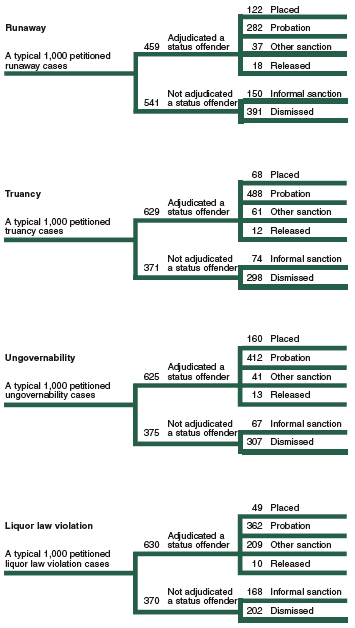
Note:
Cases are categorized by their most severe or restrictive sanction. Detail may not add to totals because of rounding.
|